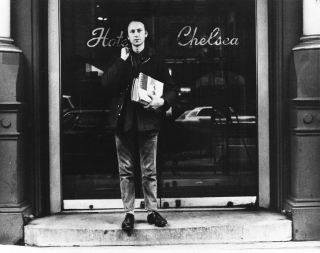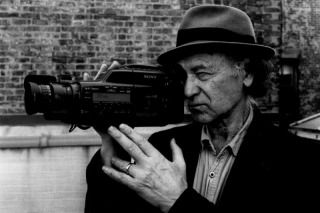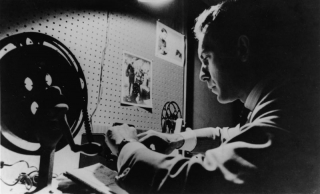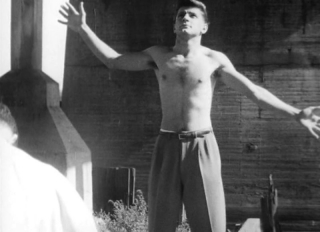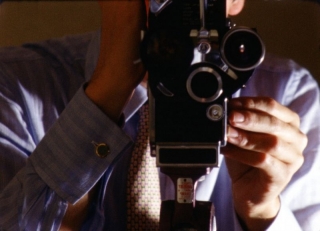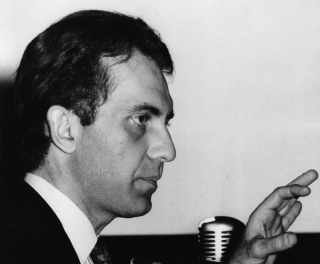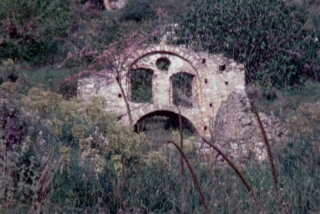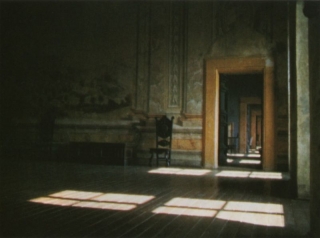Date: 21 October 2012 | Season: London Film Festival 2012 | Tags: London Film Festival
FLY INTO THE MYSTERY
Sunday 21 October 2012, at 9pm
London BFI Southbank NFT 3
Laida Lertxundi, A Lax Riddle Unit, Spain-USA, 2011, 6 min
‘In a Los Angeles interior, moving walls for loss. Practicing a song to a loved one. A film of the feminine structuring body.’ (LL)
Beatrice Gibson, Agatha, UK, 2012, 14 min
Strangers in a strange land. As the narrator recounts a dream by composer Cornelius Cardew, the viewer is transported from the hills of Snowdonia to a mental landscape where sci-fi commingles with sexual fantasy.
Lewis Klahr, Well Then There Now, USA, 2011, 11 min
Loosely interpreting a scenario by John Zorn, Klahr uses subconscious logic to weave strands of suspense from collaged images and fragments of voiceover.
Mary Helena Clark, The Plant, USA, 2012, 8 min
‘A film filled with clues and stray transmissions built on the bad geometry of point-of-view shots.’ (MHC)
Janie Geiser, Arbor, USA, 2012, 7 min
The layered imagery of Geiser’s uncanny animations suggest surreal worlds and spectral presences. ‘I was wide awake, in a dream.’
Beatrice Gibson, The Tiger’s Mind, UK, 2012, 20 min
Again referencing Cardew, Gibson’s new project The Tiger’s Mind takes his 1967 text score and applies it to the process of making a collaborative film, for which each contributor assumes the role of a character. The result is an abstract psychodrama and crime thriller set against the backdrop of a modernist house. Commissioned by The Showroom and CAC Bretigny.
PROGRAMME NOTES
FLY INTO THE MYSTERY
Sunday 21 October 2012, at 9pm
London BFI Southbank NFT 3
A LAX RIDDLE UNIT
Laida Lertxundi, Spain-USA, 2011, 16mm, colour, sound, 6 min
A Lax Riddle Unit shows a series of gentle transformations. Each of the film’s turns reveals a surprise: a woman suddenly appearing in bed, and, from behind an album cover, her shy smile. With the film’s elements of Los Angeles landscape, houseplants, and James Carr’s plaintive ‘Love Attack’, continually rearranged like the letters of the title, which is an anagram for Lertxundi’s own name, there is the sense of kaleidoscopic rotation, breathtaking views made with the slightest of movements: changing light, cuts, and slowly revolving camera pans. (Genevieve Yue)
AGATHA
Beatrice Gibson, UK, 2012, video, colour, sound, 14 min
The side of the frame flares out so you know it’s a dream. It becomes apparent that, although similar, there are profound differences between this planet and our own. The most startling is the lack of verbal language. The narrator, our guide to this world, tells us how communication happens, based on interactions with Gladys and Agatha, two beings that confound as they draw the observer in. The names are created for our benefit, and one must wonder if any observations can be trusted, are they all too written, too read from dialogue that isn’t there? What may be certain is the loosening that happens with regard to interpretation. If words cease to have importance then how can the experiences on this planet be readily expressed? Instead of syntax and meaning we are left with rhythm and colour. Based on a dream had by the radical British composer Cornelius Cardew. (Images Festival)
www.dliub.org
WELL THEN THERE NOW
Lewis Klahr, USA, 2011, video, colour, sound, 11 min
An unfaithful interpretation of John Zorn’s early 80’s film script ‘A Treatment For A Film in 15 Scenes’. I consider Well Then There Now a ‘list’ film since Zorn’s text is really a shot list. An exploration of the singularity of the image but, a playful one. Script and Music by John Zorn; Additional Text Lifts from Philippe Soupalt and Alain Robbe Grillet; Voiceover by Slater Klahr.
(Lewis Klahr)
THE PLANT
Mary Helena Clark, USA, 2012, video, colour, sound, 8 min
A film filled with clues and stray transmissions built on the bad geometry of point-of-view shots. (Mary Helena Clark)
ARBOR
Janie Geiser, USA, 2012, video, b/w, sound, 7 min
From a set of photographs found in a thrift store, Geiser creates a liminal space between representation and abstraction, figure and landscape, fiction and memory. Arbor suggests the fragility and ephemerality of memory and its artifacts through subtle manipulations of the photographs: reframings, layerings, inversions, and through the introduction of three dimensional elements, including flowers and thread. The photographs’ subjects are elusive; they rarely engage the camera; they are glimpsed, rather than seen. They look elsewhere, and wait for something inevitable. Gathering on a hillside, lounging on the grass beyond now-lost trees, the inhabitants of Arbor cycle through their one remembered afternoon, gradually succumbing to time or dissolving into landscape, reserving for themselves what we can’t know – and becoming shadows in their own stories. (Janie Geiser)
www.janiegeiser.com
THE TIGER’S MIND
Beatrice Gibson, UK, 2012, video, colour, sound, 22 min
The Tiger’s Mind is an abstract crime thriller set against the backdrop of a brutalist villa. Six characters, The Tiger, The Mind, The Tree, Wind, The Circle and a girl called Amy (the set, the music, the sounds, the special effects, the narrator and the author respectively) battle one another for control of the film as it unfolds on screen. The film explores the relationships between these characters as they emerge and unfold: grappling, wrestling, and dreaming with one another. The Tiger’s Mind is based on an experimental narrative score of the same name, written in 1967 by the radical British composer Cornelius Cardew. Departing from the character-based and improvisatory nature of the score and working with a fixed group of artists for over a year-long period (Alex Waterman as the Tree, Jesse Ash as the Wind, John Tilbury as the Mind, Celine Condorelli as the Tiger, Will Holder as Amy and Beatrice Gibson as the Circle) the film deployed the score as a production structure inviting the participants to develop its varying components: soundtrack, set, special effects, music and text. The resulting piece presents a portrait of its own making in fictional form, extending narrative and character to the production process itself. Tiger’s sets, Mind’s music, Wind’s effects, Tree’s foley, Amy’s narration and Circle’s authorship all knock up against each other in a battle for primacy. (Beatrice Gibson)
www.dliub.org
Laida Lertxundi will screen her work alongside films by Morgan Fisher, Hollis Frampton
and Bruce Baillie at the ICA Artists’ Film Club on Tuesday 23 October 2012, at 7pm.
Back to top
Date: 6 December 2012 | Season: Jonas Mekas
BRIEF GLIMPSES OF BEAUTY: THE FILMS OF JONAS MEKAS (PART ONE)
6—16 December 2012
London BFI Southbank
Cinema history would be unimaginably different if not for the essential role played by Jonas Mekas. For over half a century, he has been a tireless advocate of independent film in his capacities as critic, curator, promoter, sponsor and archivist. Mekas is also one of cinema’s true poets, whose works chronicle his remarkable life and the extraordinary people around him. From his unique perspective as participant or close observer, he has documented the independent film community and the wider cultures of art, music, and literature through the late 20th century.
Born in Lithuania in 1922, Mekas fled his homeland during World War II. Having spent time in forced labour and displaced persons camps, Jonas and his brother Adolfas were transported to New York as United Nations refugees. Soon after their arrival in 1949, they became immersed in the city’s rich film culture, attending screenings at mainstream theatres and at the Museum of Modern Art and Amos Vogel’s Cinema 16.
Devoting himself to promoting film as a personal, artistic medium, Mekas was the driving force behind many initiatives that supported alternative forms of cinema. He founded Film Culture magazine in 1954, and wrote the impassioned ‘Movie Journal’ column for the Village Voice from 1958-76. In 1960, Mekas convened The New American Cinema Group, an alliance including Shirley Clarke, Emile de Antonio and others, to encourage independent filmmaking in opposition to the industry. Positioned as an equivalent to Free Cinema and the Nouvelle Vague, their rousing manifesto asserted: “We don’t want false, polished, slick films – we prefer them rough, unpolished, but alive; we don’t want rosy films – we want them the colour of blood.” He also established the Film-Makers’ Cooperative to distribute the rapidly expanding field of avant-garde cinema, and organised regular screenings at the Film-Makers’ Cinematheque. In 1970, he co-founded Anthology Film Archives as a centre for the preservation, study and exhibition of film as an art form.
Throughout this intense period of activity, Mekas was also filming. Early works Guns of the Trees and The Brig were symptomatic of the political unrest of the time, but he soon found his metier in the diary form. In the epic films Lost Lost Lost, Walden and He Stands in a Desert, meetings with luminaries such as John and Yoko, Carl Dreyer or Jackie Onassis receive equal treatment as family dinners or drinks with friends. By impulsively recording brief fragments of his daily life, Mekas fashioned an incredible archive of cultural history during a time of significant change, and a deeply personal account of what it is to be alive.
Our Jonas Mekas season begins with the early works. In January, we will follow the diaries to the present day, and screen films by his contemporaries in tribute to Anthology Film Archives’ extraordinary Essential Cinema collection.
Curated by Mark Webber. With thanks to Benn Northover, Serpentine Gallery and Centre Pompidou. The Jonas Mekas exhibition at Serpentine Gallery is open from 5 December 2012—20 January 2013.
Date: 5 January 2013 | Season: Jonas Mekas
BRIEF GLIMPSES OF BEAUTY: THE FILMS OF JONAS MEKAS (PART TWO)
5—26 January 2013
London BFI Southbank
‘I live, therefore I make films. I make films, therefore I live.’
The Lithuanian poet and filmmaker Jonas Mekas bought his first Bolex 16mm camera within weeks of arriving in the USA as a displaced person in 1949, and from that point onwards he carried it everywhere. Rather than pursuing conventional forms of cinema, he turned the camera towards his own life, recording brief bursts of images that condense his experiences in a unique diaristic style.
The first part of our season, in December 2012, featured Mekas’ earliest films and documented his first two decades in New York. During this time he was at the centre of the New American Cinema, fostering the exhibition, distribution and critical debate of a radical new film movement. In part two we follow the diaries from the early 1970s to the present day, and further programmes explore the collection of Anthology Film Archives, the film museum that Mekas established to showcase and preserve visionary cinema.
As Mekas became less intensely involved with organising the community of filmmakers, a romantic sensibility came to the fore in his work. Nature and family life become principle themes as he raises young children, and on journeys through the city or on trips abroad, he is often drawn to more bucolic subjects.
He began the shift from film to video in the 1980s, but it wasn’t until Letter from Greenpoint that he felt truly in control of the new medium. Shooting on digital enabled a more capacious style of filming, and led to an extraordinary period of productivity. For the 365 Day Project he transmitted dispatches from his new life in Brooklyn, uploading a new short film to his website every day throughout 2007, and in 2011 he completed no less than five feature-length works including the acclaimed Sleepless Nights Stories.
Jonas Mekas’ work is an ecstatic celebration of life, friendship and the arts. His camera and tape recorder have captured momentous cultural events, but also those precious moments which he refers to as ‘Miracles of the everyday – totally insignificant, but great!’
Curated by Mark Webber. With thanks to Jonas Mekas, Benn Northover, Serpentine Gallery and Centre Pompidou. The Jonas Mekas exhibition at Serpentine Gallery continues until 27 January. www.serpentinegallery.org
Date: 8 September 2014 | Season: Gregory Markopoulos: Film as Film | Tags: Gregory Markopoulos
GREGORY J. MARKOPOULOS: FILM AS FILM
8—13 September 2014
New York Anthology Film Archives
“There is no language. There is no art. There is no knowledge. There is but film as film: the beginning and the eternal moment.” (The Intuition Space, 1973)
Gregory J. Markopoulos (1928-92) is one of the most original filmmakers to emerge from the post-war avant-garde. His films, which often translated literary or mythological sources to a contemporary context, are celebrated for their extraordinary creativity, the sensuous use of color and innovations in cinematic form. A co-founder of the New American Cinema Group, Markopoulos was actively involved in nurturing New York’s film community before moving to Europe at the end of the 1960s to pursue a more individual path. Firmly believing that a filmmaker should be responsibility for all aspects of his work, he developed the idea of Temenos, a monographic archive for the preservation, presentation and study of his films.
In parallel to his filmmaking, Markopoulos was a prolific writer whose articles were circulated in journals, self-published editions or program notes. This screening series celebrates the publication of Film as Film: The Collected Writings of Gregory J. Markopoulos, a new book that gathers together some ninety out-of-print or previously unavailable texts by the filmmaker. See www.thevisiblepress.com for more information on the book, and for details of additional events at Light Industry, The Kitchen, Harvard Film Archive and elsewhere this fall.
This is an extremely rare opportunity to see Markopoulos’ earliest works, shown alongside some of the first films made in Europe following his departure from the US in 1967. Robert Beavers and Mark Webber (the editor of “Film as Film”) will be present and the book will be available for purchase at the programmes.
Date: 8 September 2014 | Season: Gregory Markopoulos: Film as Film | Tags: Gregory Markopoulos
GREGORY J. MARKOPOULOS: FILM AS FILM 1
Monday 8 September 2014, at 7:30pm
New York Anthology Film Archives
Made as a USC student in Los Angeles, Markopoulos’ first 16mm film Psyche took as its source the unfinished novella of the same name by Pierre Louÿs. Shown together with Lysis and Charmides (both made on his return to Toledo, Ohio, and inspired by Platonic dialogues), it forms the trilogy titled Du sang de la volupte et de la mort (1947-48). By boldly addressing lesbian and homosexual themes, the trilogy gained unwelcome notices in Films in Review and Variety where, in the repressive atmosphere of the early 1950s, it was branded “degenerate” following a screening at NYU. Such a response is unimaginable today for lyrical works that express sensuality through the symbolic use of color and composition. Writing about these early films, Markopoulos chose to quote a statement by philosopher and theologian Mircea Eliade, offering viewers a clue to his entire body of work: “The whole man is engaged when he listens to myths and legends; consciously or not, their message is always deciphered and absorbed in the end.”
Gregory J. Markopoulos, A Christmas Carol, 1940, 5 min
Gregory J. Markopoulos, Du Sang, de la volupté et de la mort, 1947-48, 70 min (Essential Cinema)
Gregory J. Markopoulos, Christmas USA, 1949, 8 min
“The first thing which I did was to delete the novelette of its lush rhetoric and retain only its symbolic color. In Psyche, color plays an important role, similar to the role which color plays in the paintings of Toulouse Lautrec. Color reflects the true character of the individual before us, whether it be on the screen, in a painting, or in the street. Color is Eros.” (Psyche’s Search for the Herb of Invulnerability, 1955)
Date: 11 September 2014 | Season: Gregory Markopoulos: Film as Film | Tags: Gregory Markopoulos
MARKOPOULOS/BEAVERS: EXPERIMENTAL FILMS/EXPERIMENTAL LIVES
Thursday 11 September 2014, at 7pm
New Haven Yale Whitney Humanities Center
Introduced and followed by a conversation with Mark Webber and Robert Beavers.
Gregory J. Markopoulos, Christmas USA, 1949, 8 min
Gregory J. Markopoulos, Through a Lens Brightly: Mark Turbyfill, 1967, 15 min
Robert Beavers, Early Monthly Segments, 1968-70/2000, 33 min
Gregory J. Markopoulos, Gilbert and George, 1970/1989-91, 12 min
Robert Beavers, Listening to the Space in My Room, 2010, 19 min
Presented by the Yale Film Studies Program, Hellenic Studies Program, Yale Film Colloquium, and Films at the Whitney.
PROGRAMME NOTES
MARKOPOULOS/BEAVERS: EXPERIMENTAL FILMS/EXPERIMENTAL LIVES
Thursday 11 September 2014, at 7pm
New Haven Yale Whitney Humanities Center
CHRISTMAS U.S.A.
Gregory J. Markopoulos, 1949, 16mm, 8 min
“The film is a subtly joyous depiction of sexual and sensual awakening – a celebration of a young man’s discovery of strange, exciting things lurking beyond the drab normality of the everyday. It’s a specific metaphor for Markopoulos’ homosexuality, of course, but also more generally for the sexual and intellectual awakenings of adolescence, the escape from the family to the individual life. That Markopoulos populates this moment with such wonder, passion, and mystical tension is a testament to his sure-handed ability to convey complex emotions cinematically, even at this early stage of his career.” (Ed Howard)
THROUGH A LENS BRIGHTLY: MARK TURBYFILL
Gregory J. Markopoulos, 1967, 16mm, colour, sound, 15 min
“One of the most accomplished works in Markopoulos’s series of film portraits, Through a Lens Brightly is a vivid study of the dancer and poet Mark Turbyfill that uses paintings and photographs in his home to recapture and illuminate a life in the arts.” (Harvard Film Archive)
EARLY MONTHLY SEGMENTS
Robert Beavers, 1968-70/2000, 35mm, colour, silent, 33 min
“Early Monthly Segments, filmed when Beavers was 18 and 19 years old, now forms the opening to his film cycle, “My Hand Outstretched to the Winged Distance and Sightless Measure.” It is a highly stylized work of self-portraiture, depicting filmmaker and companion Gregory J. Markopoulos in their Swiss apartment. The film functions as a diary, capturing aspects of home life with precise attention to detail, documenting the familiar with great love and transforming objects and ordinary personal effects into a highly charged work of homoeroticism.” (Susan Oxtoby)
GILBERT AND GEORGE
Gregory J. Markopoulos, 1970/1989-91, 16mm, colour, silent, 12 min
“Gregory Markopoulos’ Gilbert and George (1970) is a film marked by absence. Though a portrait of the artistic duo, the film indulges in none of the privileging of visibility on which the genre of portraiture often rests. Much of its twelve-minute duration is filled not with likenesses of the artists but with black and white leader. Occasionally a flash of image – a pair of feet, for example – will fill the screen for a brief moment before retreating again. The flow of movement, so crucial to most films, is missing. In its place is a rigorous engagement with the medium’s most basic elements, one that returns the viewer to the stillness of the individual film frame.” (Erika Balson)
LISTENING TO THE SPACE IN MY ROOM
Robert Beavers, 2010, 16mm, colour, sound, 19 min
“Ostensibly a portrait of a place where the artist had resided until recently, the film conjures not only the memory but also the physical presence of those who have previously stayed there. Adhering to a solitary intimacy while simultaneously acting as an ode to human endeavour and shared impulses toward fulfillment through art, Listening to the Space in my Room is a moving testament to existence (whose traces are found in literature, music, filmmaking, gardening) and our endless search for meaning and authenticity. The film’s precise yet enigmatic sound-image construction carries a rare emotional weight. ” (Andréa Picard)
Back to top
Date: 29 September 2014 | Season: Gregory Markopoulos: Film as Film | Tags: Gregory Markopoulos
GREGORY MARKOPOULOS: COLLECTED WRITINGS
Monday 29 September 2014, at 7pm
New York The Kitchen
Celebrating the publication of Film as Film: The Collected Writings of Gregory J. Markopoulos (The Visible Press), filmmaker Robert Beavers, scholar Daniel Heller-Roazen, and the volume’s editor Mark Webber will lead a discussion of Markopoulos’ unique vision of film and the film spectator. Following the discussion will be a very rare screening of one reel of his magnum opus, Eniaios. This publication contains some ninety out-of-print or previously unavailable articles by the Greek-American filmmaker (1928-1992) who, as a contemporary of Kenneth Anger, Stan Brakhage and Andy Warhol, was at the forefront of a movement that established a truly independent form of cinema. Beginning with his early writings on the American avant-garde and auteurs such as Dreyer, Bresson, and Mizoguchi, it also features numerous essays on Markopoulos’ own practice, and on films by Beavers, that were circulated only in journals, self-published editions, or program notes. The texts become increasingly metaphysical and poetic as the filmmaker pursued his ideal of Temenos, an archive and screening space to be located at a remote site in the Peloponnese where his epic, final work Eniaios could be viewed in harmony with the Greek landscape.
In the last decades of his life, working quietly in Europe, Markopoulos re-edited his whole body of earlier films and dozens of new ones into one magnum opus, Eniaios. It is one of the longest films ever made: the complete film lasts approximately 80 hours and is divided into 22 cycles. From the moment he began to construct it, it was Markopoulos’ intention that Eniaios be projected only at the open-air site of what he called “The Temenos,” in a field near the village of Lyssaraia, the birthplace of his father in the Peloponnese of mainland Greece. For Eniaios, the summa of his career, Markopoulos wished to create a deeply personal and utterly unique cinematic experience. He chose the site for its natural beauty; he had conceived the Temenos as a viewing space where the physical environment would be in harmony with his idea of cinema as an instrument of philosophical and psychological revelation. In calling his projection space “The Temenos,” the filmmaker was invoking the religious traditions of ancient Greece, where a portion of land was set aside for the ritual worship of a god. The original meaning of the term “Temenos” is “a piece of land set apart.” Markopoulos wanted his life work shown in a space “set apart,” when after years of working in the international arena of the experimental film, he grew disillusioned with the interrelated commercialism of the film industry, the universities, and the art museums. He was convinced that the grandeur of what he called “film as film” required something radically different.
Gregory Markopoulos: The Collected Writings is made possible with support from Axe-Houghton Foundation and Lambent Foundation Fund of Tides Foundation, and in part by public funds from New York City Department of Cultural Affairs in partnership with the City Council and New York State Council on the Arts with the support of Governor Andrew Cuomo and the New York State Legislature.
Date: 5 October 2014 | Season: Gregory Markopoulos: Film as Film | Tags: Gregory Markopoulos
FILM AS FILM: THE CINEMA OF GREGORY MARKOPOULOS 6
Sunday 5 October 2014, at 7pm
Cambridge Harvard Film Archive
Gregory J. Markopoulos, Hagiographia II, 1970/1989-91, 60 min
Past the gates of the Temenos, and upon the twin hills the film spectator of the future will encounter the immeasurable works of Beavers and Markopoulos. On one hill will be the space of Beavers. On another hill there will be the space of Markopoulos. Here the film spectator of the future will devote himself to eternity, to the works of Beavers, to the works of Markopoulos. The spectres of distribution will have been vanquished; the spectres of projection will have been vanquished; the spectres of printing will have been vanquished. The patron of the Temenos will be he who is also unknown; hewho is without gifts of any kind; he who will be as immortal as the works being presented; he who will recognize that of all the arts only film needs a space in which to be seen; the rest is all artificial: museums, theatres and such. Only in the heart of the Peloponnesus, in Pelop’s land will film culture survive enhanced by the spirit of a truly simple and free people; the Greeks. The Greece today maligned by the truly lesser powers will be the victor.”(Gregory J. Markopoulos, The Filmmaker’s Perception in Contemplation, 1972)
Date: 31 October 2014 | Season: Gregory Markopoulos: Film as Film | Tags: Gregory Markopoulos
GREGORY J. MARKOPOULOS: FILM AS FILM
Friday 31 October 2014, at 6:30pm
London Tate Modern
Gregory J. Markopoulos is a key figure in the history of independent film and was, alongside Kenneth Anger, Stan Brakhage, Maya Deren and Andy Warhol, a pioneer of the New American Cinema of the 1960s. This special evening celebrates the publication of Film as Film: The Collected Writings of Gregory J. Markopoulos, edited by Mark Webber, that gathers together for the first time the writings of this important filmmaker.
Gregory J. Markopoulos, Psyche, USA, 1947, 16mm, 25 min
Gregory J. Markopoulos, Bliss, Greece, 1967, 16mm, 6 min
Gregory J. Markopoulos, Gammelion, Italy, 1968, 16mm, 55 min
The evolution of Markopoulos’ filmmaking – from the early films of the 1940s to his increasingly poetic and metaphysical works made in Europe from the late 1960s onwards – is traced in his writings, which also address the avant-garde cinema, auteurs such as Dreyer, Bresson and Mizoguchi, and the work of his partner Robert Beavers. As Markopoulos pursued his ambitious plan to establish The Temenos, a screening space and archive devoted to his work that would be located in a remote part of Greece, his unique vision of a truly independent cinema was proposed through his texts and has inspired a diverse array of artists. Tacita Dean has celebrated the forthcoming publication stating, “it feels apposite that the writings of Gregory Markopoulos be published now at a time when the very existence of film is so threatened. Nothing more should be needed as a convincing argument that film is still the important, autogenic magical medium for filmmakers today.”
Following screenings of films by Gregory J. Markopoulos at Tate Modern in 2008, this evening will feature works not previously shown at Tate that illustrate key points in Markopoulos’ career interspersed with readings from the book. Made while studying at USC in Los Angeles, Psyche 1947, was his first 16mm film, and demonstrates Markopoulos’ developing style and his sensuous use of colour and composition. Shot in the Hollywood hills, the film was inspired by an unfinished novella by Pierre Louÿs, yet as Markopoulos described “the first thing which I did was to delete the novelette of its lush rhetoric and retain only its symbolic colour. In Psyche, colour plays an important role, similar to the role which colour plays in the paintings of Toulouse Lautrec. Colour reflects the true character of the individual before us, whether it be on the screen, in a painting, or in the street. Colour is Eros.” (Psyche’s Search for the Herb of Invulnerability, 1955).
Bliss 1967, the first film made after Markopoulos moved from the USA to Europe, is a lyrical study of the interior of the Byzantine Church of St. John on the island of Hydra. Using only available light and edited in camera, Bliss demonstrates the filmmaker’s aesthetic economy and rigour. Gammelion 1968, filmed at Il Castello Roccasinibalda in Rieti, Italy, is a major work in Markopoulos’s oeuvre, marking the transition into his late period and anticipating his epic final film, Eniaios 1947-91. Shot with only two rolls of film, the work extends seven minutes of footage to almost one hour of viewing time using hundreds of fades in and out. As lines of poetry, music, or the sound of horses’ hooves are heard on the soundtrack, images appear for only a few frames at a time, creating a remarkable romantic vision of a poetic cinema conjured from its essential components.
Curated by George Clark and Mark Webber. Introduced by Mark Webber and Robert Beavers.
Date: 20 November 2014 | Season: Gregory Markopoulos: Film as Film | Tags: Gregory Markopoulos
THE ILLIAC PASSION
Thursday 20 November 2014, at 8:30pm
Vienna Austrian Filmmuseum
In the presence of Robert Beavers
Gregory J. Markopoulos, The Illiac Passion, 1964-67, 91 min
Gregory J. Markopoulos, Rushes for The Illiac Passion, c.1965, 12 min
Gregory J. Markopoulos, Test with Masques for The Illiac Passion, 1966, 3 min
„Illiac” beschreibt das Auf- oder Erstellen einer Sache. Es ist ein anderer Name für poiesis, das Ursprungswort fürs Erschaffen, für das Filme-in-die-Welt-Setzen des „Filmemachers”. The Illiac Passion ist ein Film-als-Film-Kontinent und poetisch verschlüsseltes Selbstporträt, mit dem Markopoulos über sich als einen anderen (namens Prometheus) und über die Leidenschaften des Erzeugens von Werken (also auch von Filmen, also auch über die passions von Illiac Passion) erzählt. The Illiac Passion ist ein Mythen-Irrgarten, beglänzt vom Licht des Sterns Farbe-ist-Eros. Film, in dem Griechenlands Götter sich nach Manhattan begeben und in dem das Erhabene und Gewöhnliche nicht müde werden, einen tollkühnen, tragischen, magischen Tanz aus flackernden single frames, Doppelbelichtungen, Metaphern und schierer Bildpracht zu tanzen: die Summe der maßlosen wie maßvollen Markopoulos-Filmschrift. (Harry Tomicek)

